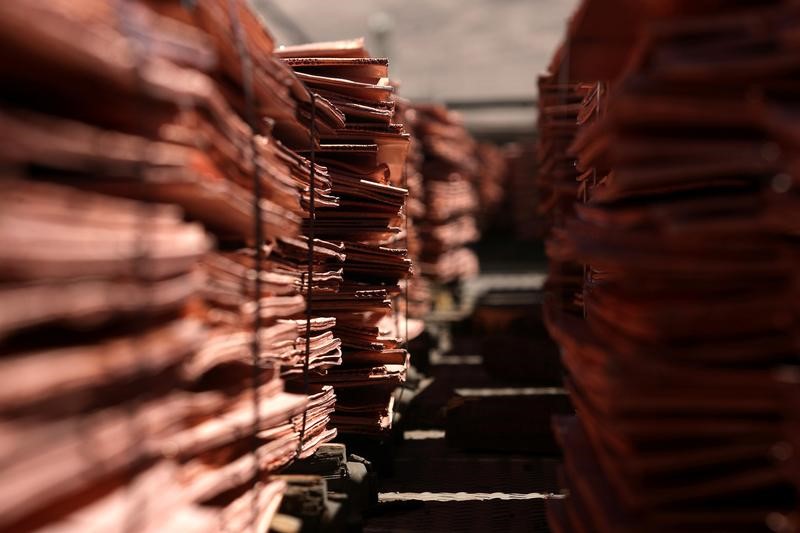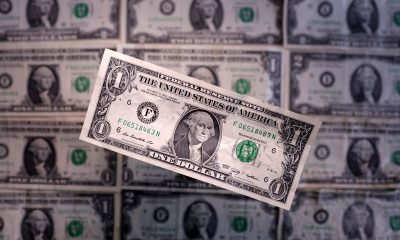Commodities
Gold and copper prices rally as US inflation data softens


© Reuters.
Precious metals, including gold, experienced a notable surge on Tuesday as the U.S. consumer price index (CPI) for October showed inflation pressures easing more than expected, raising market speculation about a less aggressive Federal Reserve stance on interest rates. The CPI remained unchanged from the previous month and saw a minor annual increase of 3.2%, according to the Bureau of Labor Statistics.
This softer inflation data has led to a significant decrease in the value of the dollar and Treasury yields, diminishing the likelihood of another imminent rate hike by the Federal Reserve. As a result, on the COMEX division rose by $16.30 to close at $1,966.50 per ounce. in New York also climbed by 1.1% to $1,967.54 an ounce, marking the highest intraday increase since October 27.
The optimism extended to base metals as well, with prices on the London Metal Exchange (LME) increasing by 1.1% to $8,255 a metric ton. High interest rates typically dampen demand for base metals from critical sectors like construction and manufacturing while reducing their investment appeal.
Swaps traders are now pricing in two Federal Reserve rate cuts by July next year, a shift from just one anticipated cut before the inflation report was released. However, Wall Street banks remain divided over how quickly policy easing might occur in 2024.
The market’s reaction was further influenced by comments from various officials and analysts. Federal Reserve Vice Chair Philip Jefferson emphasized the need for more forceful action due to high inflation uncertainty while speaking at a Zurich conference.
The broader impact was seen across stock markets, with major indexes such as the Dow Jones, , and Index all closing higher. European markets followed suit, buoyed by the U.S. inflation data.
The news also brought comfort ahead of a meeting between US President Joe Biden and Chinese leader Xi Jinping, which is seen as a positive sign amidst global economic uncertainty.
Additionally, precious metals like silver and platinum for December and January delivery respectively saw increases as well. This general uptick in precious metal prices aligns with the slight decrease in small-business optimism reported by the National Federation of Independent Business for October, reflecting cautious economic sentiment among small businesses amid inflationary concerns.
While inflation is slowing down and remains above the Fed’s two-percent target, Fed Chairman Jerome Powell and other officials have signaled readiness to hike rates again if necessary. The recent developments have also sparked discussions about a possible “soft landing” for the economy.
In related commodities news, North Sea crude and West Texas Intermediate prices showed stability despite ongoing concerns about high British interest rates sparked by UK wages rising faster than inflation. In contrast, a sharp fall is expected in British annual inflation.
The drop in inflationary pressures also led to gains for raw material producers and marked what could be the end of the Federal Reserve’s rate-hike cycle according to some Wall Street strategists.
In mining news, Teck Resources (NYSE:)’ sale of its coal assets to Glencore (OTC:) marked the biggest mining deal of the year, ending a lengthy saga that had been closely watched by investors and industry observers alike.
This article was generated with the support of AI and reviewed by an editor. For more information see our T&C.
Commodities
Oil prices rise; U.S. crude inventories plunge, Russia-Ukraine truce eyed
Commodities
India’s Reliance to stop buying Venezuelan oil over US tariffs, sources say
Commodities
Oil prices climb on Venezuela supply worries

 Forex3 years ago
Forex3 years agoForex Today: the dollar is gaining strength amid gloomy sentiment at the start of the Fed’s week

 Forex3 years ago
Forex3 years agoUnbiased review of Pocket Option broker

 Forex3 years ago
Forex3 years agoDollar to pound sterling exchange rate today: Pound plummeted to its lowest since 1985

 Forex3 years ago
Forex3 years agoHow is the Australian dollar doing today?

 Cryptocurrency3 years ago
Cryptocurrency3 years agoWhat happened in the crypto market – current events today

 World3 years ago
World3 years agoWhy are modern video games an art form?

 Commodities3 years ago
Commodities3 years agoCopper continues to fall in price on expectations of lower demand in China

 Economy3 years ago
Economy3 years agoCrude oil tankers double in price due to EU anti-Russian sanctions



























